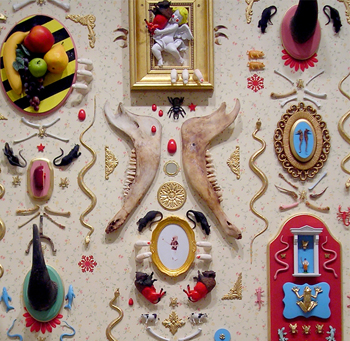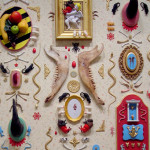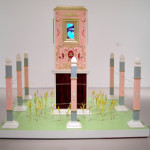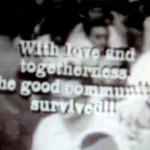By JORGE ESPADA VALENZUELA
Jorge Espada Valenzuela: After being awarded the Traveling Scholarship from the School of the Museum of Fine Arts, you set out for a backpacking tour throughout the American Southwest after having spent time exploring Alaska. What was your attraction to these places?
Mathew Freeman: I’ve spent a great deal of time in the Southwest visiting family as a child. Almost all of that time was spent on ranchland in those days. It’s an incredibly nostalgic place. In August 2006 I arrived in Albuquerque and was overwhelmed by the corporate hegemony that has taken hold throughout the region in regards to the strip malls, condominiums and commercially driven artwork.
I had just come from Alaska where I’d flown to the Katmai region, an area that had been inhabited by people for roughly 15,000 years. I crossed over six hundred miles without seeing a fence, footprint, or structure of any kind. The only sign of artifice were ruinous pits from long-decomposed igloos. Alaska had never been tamed in the way I’ve grown accustomed to expect from my culture.
JEV: There’s a consistent use of symmetry in all four of your works in the exhibition. Plastic toys and animal parts often mirror each other in pairs.
Is this conducive to the kind of “taming” you mention?
MF: I’ve been very inspired by the symmetry found in the Victorian Aesthetic. The intention of these artists and designers was to organize natural elements as a way to invoke feelings of invitation, much in the same way that a garden does. However, all the flowing vines, leaves, fruits and flowers are being constrained unnaturally, within a format often found in religious art… centerline and balance. To me, this is just as easily an expression of dominance and control, so I’ve chosen to use it that way.
JEV: The work entitled Monocultural Structure in a Field consists of a six-foot-high tower that contains four video monitors, all looping unblinking eyes that peek through openings on all four sides. Plastic wheat stalks, as well as a gilded barbed-wire fence surrounds everything. How do you define “monoculture”?
MF: Monoculture is a term for a farm or an agricultural region that produces only one crop. A good example takes place in Ireland during its potato years, when every single potato in the country was genetically identical…so when one of them caught a disease, they all did. Another example would be the entire Midwestern cornfield.
These sorts of transactions with the Earth seemed to be indicative of many other things. In the suburbs for example, everything is constructed to exclusively fit the proportions of the human body and nothing else.
The inspiration behind the tower came from various historical forts and blockhouses planted all over the country. For me, these are great examples of devices used for both racial and ecological authority…simply by exterminating the cultures whose agricultural methods were less one-sided than European methods. The tower is a metaphor for anything from the Green Zone in Iraq, to any suburban neighborhood that gets hysterical when a coyote is spotted.
JEV: By visually harmonizing familiar indicators of indoor and outdoor environments, is your intention to obscure any ideological partitions between these two surroundings?
MF: I think these two surroundings are inevitably blended together, even if our perceptions tell us otherwise. Coming from a cultural lineage that transforms it’s environment to live up to the requirements of the society, (rather than the other way around), I often feel like I’m in an indoor environment even when I’m outside.
JEV: Some of your chosen objects include plastic bugs, snakes, spiders, animal bones, claws and horns. Seeing these elements mounted upon flowery wallpaper along with more classic elements of the home can have a disturbing effect for some people. Is this your intention?
MF: Definitely not, but I always find it intriguing when people react in such a way to those kinds of things. It seems to have more to do with the traditionally acceptable “man-versus-nature” thing than any actual danger.
The video Derangement in the Community uses the man-versus-nature literary device and celebrates that tradition. I think it’s a very old reflex that all the wind, solar and hydrogen in the world can’t change.
JEV: On your business card it says “Hunter/Gatherer” for the job title. Can you elaborate on this?
MF: There are many hunters and gatherers alive today who are literally dying to keep that profession. I admire the way it’s centered entirely on self-reliance. Having said that, putting the term on my business card has a “self-help” agenda more than anything else.
- Mathew Freeman, Spring is a Perhaps Hand that doesn’t Break Anything (detail), mixed media on panel, 2007
- Mathew Freeman, Monocultural Structure in a Field, mixed media installation, 2007
- Mathew Freeman, still from color video Derangement in the Community, DVD, 2007
Museum of Fine Arts, Boston
Gallery Diet
"SMFA Traveling Scholars" was on view until March 2nd, 2008, in the Foster Gallery at the Museum of Fine Arts, Boston, located at 465 Huntington Ave., Boston, MA.
All images are courtesy of the artist and the MFA.







